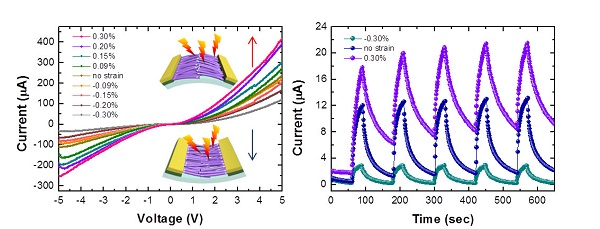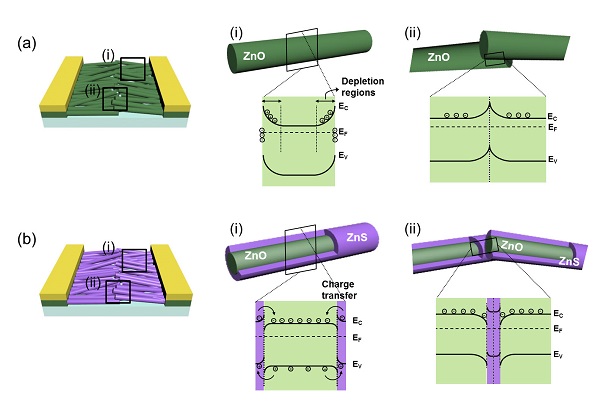Media Center
A multimedia mosaic of moments at GIST
GIST Excellence
[Press Release] Professor Seong-Ju Park"s research team develops high efficiency photodetector to improve internet performance
- 엘리스 리
- REG_DATE : 2016.11.24
- HIT : 948
Professor Seong-Ju Park"s research team develops
high efficiency photodetector to improve internet performance

Figure 1. (Left) Sanning electron microscope image (right)
of zinc oxide / zinc sulphide core / shell nanowire grown sideways on a
flexible substrate.
□ Professor
Seong-Ju Park of the Department of Materials Science and Engineering at the
Gwangju Institute of Science and Technology (GIST) led a research team that has
developed a photodetector * that can dramatically improve the performance of
next generation multifunction sensors used in the internet of things (IoT).
∘ The photodetector developed by
the research team is expected to contribute to the spread of "high-efficiency
multi-function sensor" which can integrate various sensors by expanding the
application range of pressure sensors, gas sensors, and biosensors.
* Photodetector: Light incident to a
semiconductor material generates electrons, and holes in a semiconductor
material cause electrons to flow in accordance with an applied electric field
to generate a current. Photodetectors are used in various fields such as smart
watches, wearable electronic devices, health and medical devices, ultraviolet
sterilization purifiers, and fire detection systems.
□ High efficiency optical
sensors are widely used in optical communications, visual imaging, cameras,
precision medical devices, etc. Especially, in order to allow the "Internet of
things", which is considered to be a core technology in the 4th industrial revolution
era, it is necessary to achieve energy efficiency.
However, single nanowire-based devices used in optical sensors are difficult to commercialize because they have issues with various technical problems regarding their considerably low output.

Figure 2. Graph
showing the electrical characteristics (left) and light response
characteristics (right) of zinc oxide / zinc sulphide core / shell nanowire
device with strain variation. When externally illuminated, the highest
photocurrent (as in the pink curve in the left graph) and excellent optical
response characteristics (such as the purple curve in the right graph) is seen when
having a tensile strain of 0.3% at the same drive voltage.

By aligning a 1-dimensional nanostructure based on zinc oxide (ZnO) on a flexible substrate and then changing the piezoelectric property * of the nanostructure, the team succeeded in improving optical response and electrical properties at the same drive voltage.
* Piezoelectric properties: the properties of a particular material that can be converted between mechanical and electrical energy: Apply mechanical pressure to generate voltage, and apply voltage to cause mechanical deformation.
* Photoresponsiveness: The most representative factor for evaluating photodetector characteristics. It is expressed by the magnitude of the electric current generated by electrons and holes generated per unit intensity of incident light. If light response is high, light of very weak intensity can be easily detected.
In order to increase the output of zinc oxide nanowires, the
researchers synthesized zinc oxide nanowires laterally on a flexible substrate
and then synthesized the surface with zinc sulfide (ZnS) and adjusted the
strain so that it has high light responsiveness even at a driving voltage.
◯ When the zinc oxide-zinc sulfide
core / shell structure is formed, the probability of recombination of electrons
and holes generated when external light is irradiated is lowered, and the
photocurrent was greatly increased.
In this zinc oxide-zinc sulphide core / shell nanowire
structure, the device was bent through external pressure to increase the output
current by 8.93 times and the light responsiveness by 23.9 times compared to
the control zinc oxide nanowire at a strain of 0.3% .
□ Professor Seong-Ju Park said,
"This achievement will contribute to improving energy efficiency by lowering
the driving voltage of the internet, human machine Interface, etc., which
depend heavily on the performance of the photodetector. In addition, this will
also benefit sensors as well as bio-adaptive multifunction smart sensors."
□ The research conducted by
GIST Professor Seong-Ju Park (corresponding author) and Dr. Jeong Se-hui Professor
Seong-Ju Park (first author) was carried
out with the support from the Industrial Technology Innovation Development
Project and the GIST Research Institute Project of the Ministry of Industry and
Trade. The paper appeared on September 28, 2016, in the online edition of Nano
Energy, which is the authoritative site for nanomaterials.